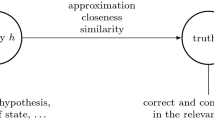Abstract
The main formal notion involved in qualitative truth approximation by the HD-method, viz. ‘more truthlike’, is shown to not only have, by its definition, an intuitively appealing ‘model foundation’, but also, at least partially, a conceptually plausible ‘consequence foundation’. Moreover, combining the relevant parts of both leads to a very appealing ‘dual foundation’, the more so since the relevant methodological notions, viz. ‘more successful’ and its ingredients provided by the HD-method, can be given a similar dual foundation.
According to the resulting dual foundation of ‘naive truth approximation’, the HD-method provides successes (established true consequences) and counterexamples (established wrongly missing models) of theories. Such HD-results may support the tentative conclusion that one theory seems to remain more successful than another in the naive sense of having more successes and fewer counterexamples. If so, this provides good reasons for believing that the more successful theory is also more truthlike in the naive sense of having more correct models and more true consequences.
In the dual foundation of ‘refined truth approximation’, HD-results remain of the same two kinds, but ‘more successful’ is taken in the refined sense of accommodating counterexamples while saving relevant successes, in which case ‘more truthlike’ can be taken in the refined sense of improving relevant models while saving relevant consequences. In this way one gets a realistic dual account of qualitative truth approximation by the HD-method.
The model foundation can also be extended to the methodological notions, but not in a very plausible way. The consequence foundation only seems specifiable for naive truth approximation, in which case it is plausible. In sum, the dual foundation is superior to both.
Similar content being viewed by others
REFERENCES
Cools, K., Hamminga, B., and Kuipers, T.: 1994, 'Truth Approximation by Concretization in Capital Structure Theory', in B. Hamminga and N. B. deMarchi (eds.), Idealization VI: Idealization in Economics, Poznan Studies, Vol. 38, Rodopi, Amsterdam, pp. 205-228.
Hettema, H. and Kuipers, T.: 1995, 'Sommerfeld's Atombau: A Case Study in Potential Truth Approximation', in T. Kuipers and A. R. Mackor (eds.), Cognitive Patterns in Science and Common Sense, Poznan Studies, Vol. 45, Rodopi, Amsterdam, pp. 273-297.
Kieseppä, I.: 1994, 'Assessing the Structuralist Theory of Verisimilitude', in M. Kuokkanen (ed.), Idealization VII: Structuralism, Idealization and Approximation, Poznan Studies, Vol. 42, Rodopi, Amsterdam, pp. 95-108.
Kuipers, T.: 1982, 'Approaching Descriptive and Theoretical Truth', Erkenntnis 18, 343-387.
Kuipers, T. (ed.): 1987a, What is Closer-to-the-Truth? A Parade of Approaches to Truthlikeness, Poznan Studies, Vol. 10, Rodopi, Amsterdam.
Kuipers, T.: 1987b, 'A Structuralist Approach to Truthlikeness', in Kuipers (1987a), pp. 79-99.
Kuipers, T.: 1992, 'Naive and Refined Truth Approximation', Synthese 93, 299-341.
Kuipers, T.: 1995, 'Falsificationism Versus Efficient Truth Approximation', in W. Herfel, W. Krajewski, I. Niiniluoto, and R. Wojcicki (eds.), Theories and Models in Scientific Processes, Poznan Studies, Vol. 44, Rodopi, Amsterdam, pp. 359-386.
Kuipers, T.: 1996, 'Truth Approximation by the Hypothetico-Deductive Method', in W. Balzer and U. C. Moulines (eds.), Structuralist Theory of Science, De Gruyter Verlag, Berlin, pp. 83-113.
Miller, D.: 1974, 'Popper's Qualitative Theory of Verisimilitude', The British Journal for the Philosophy of Science 25,166-177.
Miller, D.: 1978, 'On Distance from the Truth as a True Distance', in J.Hintikka et al. (eds.), Essays on Mathematical and Philosophical Logic, Reidel, Dordrecht, pp. 415-435.
Miller, D.: 1990, 'Some Logical Mensuration', The British Journal for the Philosophy of Science 41, 281-290.
Mormann Th.1988'Are All False Theories Equally False'British Journal for the Philosophy of Science 394505-519
Niiniluoto, I.: 1987, Truthlikeness, Reidel, Dordrecht.
Oddie, G.: 1981, 'Verisimilitude Reviewed', The British Journal for the Philosophy of Science 32, 237-265.
Oddie, G.: 1986, Likeness to Truth, Reidel, Dordrecht.
Popper, K. R.: 1963, Conjectures and Refutations, Routledge and Kegan Paul, London.
Tichý, P.: 1974, 'On Popper's Definition of Verisimilitude', The British Journal for the Philosophy of Science 25, 155-160.
Zwart, S. D.: 1995, 'A Hidden Variable in the Discussion About 'Language Dependency' of Truthlikeness', in T. Kuipers and A. R. Mackor (eds.), Cognitive Patterns in Science and Common Sense, Poznan Studies, Vol. 45, Rodopi, Amsterdam, pp. 249-272.
Author information
Authors and Affiliations
Rights and permissions
About this article
Cite this article
Kuipers, T.A.F. The Dual Foundation of Qualitative Truth Approximation. Erkenntnis 47, 145–179 (1997). https://doi.org/10.1023/A:1005309831490
Issue Date:
DOI: https://doi.org/10.1023/A:1005309831490




